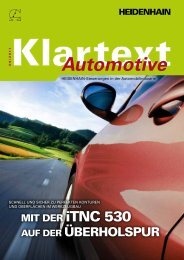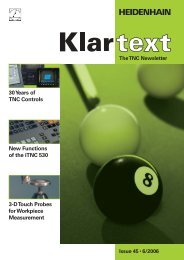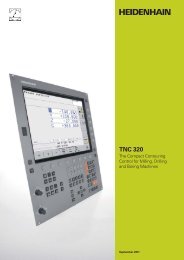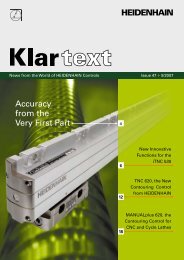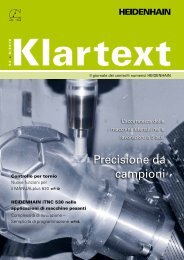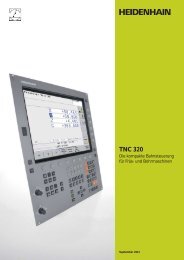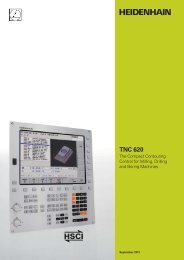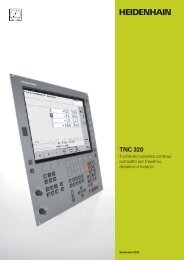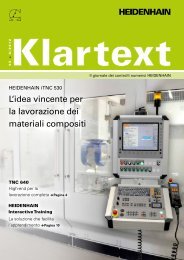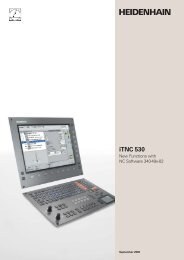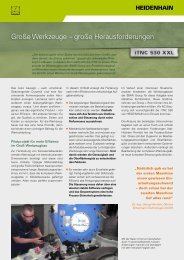iTNC 530 - TNC 640 - DR. JOHANNES HEIDENHAIN GmbH
iTNC 530 - TNC 640 - DR. JOHANNES HEIDENHAIN GmbH
iTNC 530 - TNC 640 - DR. JOHANNES HEIDENHAIN GmbH
Create successful ePaper yourself
Turn your PDF publications into a flip-book with our unique Google optimized e-Paper software.
– The <strong>i<strong>TNC</strong></strong> Programming Station<br />
Why a programming station?<br />
Everyone knows that you can easily write a<br />
part program with the <strong>i<strong>TNC</strong></strong> at the machine,<br />
even while it’s machining another part.<br />
Nevertheless, it can often happen that<br />
short reloading times and other machining<br />
tasks hinder any prolonged or concentrated<br />
programming work. With the <strong>i<strong>TNC</strong></strong><br />
programming station you have the<br />
capability to program just as you do at the<br />
machine, but away from the noise and<br />
distractions of the shop fl oor.<br />
Creating programs<br />
Programming, testing and optimizing your<br />
smarT.NC, <strong>HEIDENHAIN</strong> conversational or<br />
DIN/ISO programs for the <strong>i<strong>TNC</strong></strong> <strong>530</strong> with<br />
the programming station substantially<br />
reduces machine idle times. You need<br />
not adjust your way of thinking—every<br />
keystroke fi ts. On the programming station<br />
you program on the same keyboard as at<br />
the machine.<br />
Testing of programs created offl ine<br />
Of course you can also test programs that<br />
were written on a CAM system. The highresolution<br />
program verifi cation graphics<br />
help you even with complex 3-D programs<br />
to easily spot contour damage and hidden<br />
details.<br />
Training with the <strong>i<strong>TNC</strong></strong> programming<br />
station<br />
Because the <strong>i<strong>TNC</strong></strong> programming station<br />
is based on the same software as the<br />
<strong>i<strong>TNC</strong></strong> <strong>530</strong>, it is ideally suited for apprentice<br />
and advanced training. The program is<br />
entered on the original keyboard unit. Even<br />
the test run functions exactly as it does on<br />
the machine. This gives the trainee the<br />
experience needed to enable him to safely<br />
operate the machine later.<br />
Because it can be programmed with<br />
smarT.NC, in plain language, and in DIN/<br />
ISO, the <strong>i<strong>TNC</strong></strong> programming station can<br />
also be used in schools for <strong>TNC</strong><br />
programming training.<br />
More information about the programming<br />
station and a free demo version is<br />
available on the Internet at<br />
www.heidenhain.de. Or simply ask for<br />
the <strong>i<strong>TNC</strong></strong> Programming Station CD or<br />
brochure.<br />
The workstation<br />
The <strong>i<strong>TNC</strong></strong> programming station software<br />
runs on a PC. The programming station is<br />
only slightly different from an <strong>i<strong>TNC</strong></strong> built<br />
onto a machine tool. The familiar <strong>TNC</strong><br />
keyboard remains unchanged except that it<br />
now includes the soft keys, which are<br />
otherwise integrated in the visual display<br />
unit. You connect the <strong>i<strong>TNC</strong></strong> keyboard to<br />
your PC’s USB port. The PC screen displays<br />
the familiar <strong>TNC</strong> user interface.<br />
Or as an alternative, you can even operate<br />
the programming station without an <strong>i<strong>TNC</strong></strong><br />
keyboard. You can use a virtual keyboard<br />
instead—it is displayed together with the<br />
<strong>i<strong>TNC</strong></strong> Control Panel and features the most<br />
important dialog initiation keys of the <strong>i<strong>TNC</strong></strong>.<br />
41



